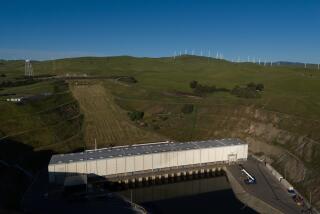Supercharging China’s Engine
GUANGZHOU, China — For two decades the Pearl River Delta has been the engine of China’s emergence as a global economic power.
If it was an independent country, the greater delta -- including Hong Kong and Macau -- would be East Asia’s fourth-largest economy and its second-largest exporter. Its sprawling, gray cities with little-known names like Shenzhen, Dongguan and Foshan collectively draw foreign investment at an astounding rate of nearly $2 billion a month.
It could soon get bigger.
Central government plans to revive Hong Kong’s flagging fortunes -- including building one of the world’s largest bridges across the Pearl River estuary -- are expected to provide a supercharging effect to the vast delta that forms the territory’s hinterland.
Experts believe that the plans will accelerate a level of growth that has already turned the once-sleepy agricultural backwater of southern Guangdong province into a smoggy industrial landscape of countless nondescript factories squeezed between small rice paddies and a warren of waterways.
“While it is couched in terms of what the mainland government is doing to help Hong Kong, the biggest beneficiaries will be Guangdong and the delta,” noted Michael Enright of Hong Kong University’s School of Business.
Summed up Wang Li-wen, deputy director of Guangdong’s Center for Development Research in Guangzhou: “It’s going to be a big lift for everyone in the region.”
The impact of these measures extends far beyond the delta.
Within China, planners say, the moves will ease the isolation of southern China’s poorer inland provinces of Guangxi and Hunan, bringing new opportunities for their development. But the measures will probably make life harder for governments elsewhere in Asia and Latin America already struggling to keep vital foreign investment dollars from migrating to China.
The delta’s combination of cheap labor, a ready managerial pool and fast links to the outside world have made it a mecca for thousands of export-driven small- and medium-sized light industrial companies churning out everything from textiles and electronics to telephones, motorcycles and toys. It is also a home for the likes of IBM, Honda, Samsung and Wal-Mart, which runs a major procurement operation from Shenzhen.
The central government’s stimulus package for Hong Kong is impressive. It includes a free trade agreement between the quasi-autonomous territory and the mainland, and an easing of restrictions on mainland tourist travel to Hong Kong. But the centerpiece is the planned bridge across the Pearl River estuary linking Hong Kong directly to the lesser developed western delta near the city of Zhuhai.
Two routes for the bridge are now under consideration. Depending on the route, design and other factors, the span would cost up to $4 billion, stretch up to 25 miles and cut minimum road-travel time between the two cities from four hours to just 40 minutes. That would open up new areas west of the estuary that have long been viewed by potential investors as too inaccessible to Hong Kong and global markets beyond.
Central government planners estimate the bridge would carry 45 million to 65 million passengers a year by 2020, propel both business and tourism growth and place Hong Kong in the middle of a new transportation loop rather than at the end of a cul-de-sac.
Still undecided is whether the bridge should carry road vehicles only or trains as well. A road-only span would cut costs nearly in half, but planners say the rail option could help ease auto traffic in a region already beginning to suffer from Southern California-like congestion.
Either way, experts such as Enright argue that the bridge has the potential to transform the delta region -- drawing low-tech producers such as garment and toy makers away from the increasingly crowded east to the western delta where labor costs are lower. This, in turn, would free up overcrowded land in the east for a new wave of high-tech investment.
Wang cited shortages of land and potable water as the biggest impediments to new growth in the eastern delta.
Still, the new plans have spurred optimism.
“I predict the west side of the delta will grow faster in the next 10 years than the east did in the past 10,” Enright said.
Most of the measures aimed at integrating Hong Kong more closely with the rest of the delta -- including the bridge -- have been discussed for years. But many only moved toward reality this year after Beijing saw them as a way to reverse Hong Kong’s stubborn economic decline.
The steps took on greater urgency after last spring’s fight to contain an outbreak of the pneumonia-like SARS virus further demoralized Hong Kong. Last month’s anti-government demonstrations that brought more than half a million protesters onto Hong Kong’s streets elevated the plans to near-emergency status.
A new Hong Kong-mainland free trade agreement, initially criticized as more symbol than substance when it was signed in late June, was quickly expanded to include broad concessions for service sectors vital for Hong Kong’s survival. The move also helps Guangdong, whose growth has brought shortages of important services such as marketing, accounting and transport logistics.
Plans were also accelerated to allow mainland tourists to visit Hong Kong on their own rather than only in state-sponsored groups. Beginning last month, residents of four mainland delta cities were allowed to apply for tourist visas to visit as individuals. Portrayed as a trial run, the program was quickly expanded last week to three other Guangdong provincial cities and next month will be extended to residents of Beijing and Shanghai.
Initial reports indicate that at least some mainlanders are spending big in the territory. Shiu Sin Por, director of a Hong Kong-based political think tank, recalled several recent instances of mainland Chinese snapping up choice Hong Kong property in a falling market with few local buyers.
Such stories underscore just how much has changed in the 25 years since the border reopened between China’s destitute south and a dazzling rich Hong Kong, whose residents took refrigerators and TV sets to poor mainland relatives.
But the biggest surprise was Beijing’s handling of the proposed estuary bridge, an idea that had kicked around for years and seemed hopelessly bogged in bureaucratic squabbling between local governments in the delta, each jostling for influence over the project.
A central government study of the bridge released last month was quickly endorsed by the governments of Hong Kong, Macau and Guangdong, then immediately presented to China’s State Council, or Cabinet.
Within four days, the council gave the green light for detailed planning of the bridge. Mainland leaders also brought an abrupt halt to local jurisdictional wrangling, winning approval from competing local governments that Hong Kong should take the lead on the project’s design.
In a greater delta region that includes two quasi-autonomous administrative regions (Hong Kong and Macau), three special export zones, one provincial government and 26 county, city and other subregional authorities, the real question now is if this cooperation can last.
“The problem in the delta is there’s a lot of rivalry,” noted Peter Cheung, a Hong Kong University specialist in politics and public administration. “There’s been a lot of progress, but there are many difficulties too.”
More to Read
Sign up for Essential California
The most important California stories and recommendations in your inbox every morning.
You may occasionally receive promotional content from the Los Angeles Times.










